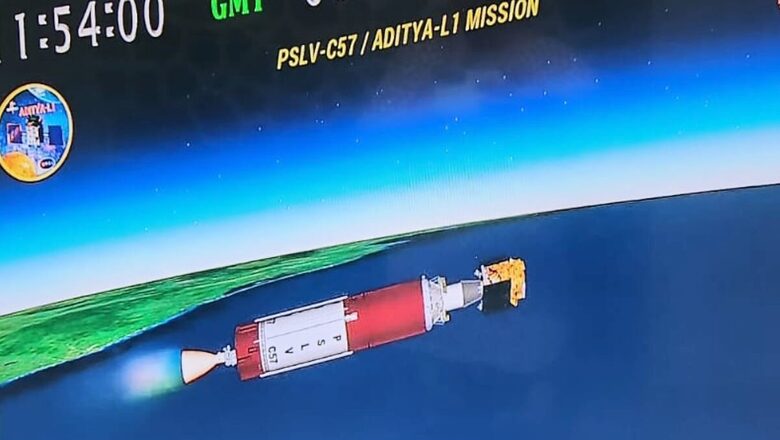
views
Aditya L1 Mission Latest Updates: The Indian Space Research Organisation (ISRO) is ready with its next space mission in a space of 2 months, as the space agency gears up for its first-ever mission to the sun on Saturday, September 2 from Sriharikota in Andhra Pradesh. After successfully landing on the south side of the Moon with the Chandrayaan 3, ISRO is running down the clock for the launch of the Aditya-L1 mission which is going to be India’s first dedicated scientific mission to study the Sun.
Aditya L1 Mission Latest updates:
The stage is finally set! ISRO’s Aditya L1 solar mission is launching at 11:50 a.m. Stay tuned for the latest updates!
The stage-3 separation of PSLV C-57 has been completed. Visuals come in from Satish Dhawan Space Centre (SDSC) SHAR, Sriharikota after the launch of Aditya-L1.
#WATCH | Visuals from Satish Dhawan Space Centre (SDSC) SHAR, Sriharikota after the launch of Aditya-L1.The third stage of the separation of PSLV has been completed. pic.twitter.com/b88rRvXNSr
— ANI (@ANI) September 2, 2023
Visuals of the PSLV rocket, carrying the Aditya L1 solar mission, after its launch from the Satish Dhawan Space Center in Sriharikota. So far all signals are healthy, as per ISRO.
Visuals of the PSLV rocket, carrying the Aditya L1 solar mission, after its launch from the Satish Dhawan Space Center in Sriharikota. So far all signals are healthy, as per ISRO.(Source: @isro) #AdityaL1Launch pic.twitter.com/1O3PEPsPvD
— Press Trust of India (@PTI_News) September 2, 2023
After clean take-off, the Aditya-L1 payload has achieved a successful separation from the spacecraft.
VIDEO | Solar telescope placed in the University of Lucknow ahead of the launch of ISRO’s Aditya-L1 Mission.#AdityaL1Launch #AdityaL1Mission #AdityaL1MissionLaunch pic.twitter.com/UDhvvCvjFl— Press Trust of India (@PTI_News) September 2, 2023
Aditya-L1 solar mission live telecast is available on the ISRO website, its YouTube channel, Facebook, and DD National TV from 11.50 AM (IST).
Visuals from Satish Dhawan Space Centre in Sriharikota, Andhra Pradesh ahead of the launch of Aditya-L1 Mission by ISRO.
#WATCH | “We are very proud to be an Indian, we are very happy to be here to watch the launching. This is the first time, I have come here. We can’t explain our happiness,” says Bama, who arrived at Satish Dhawan Space Centre in Sriharikota from Chennai to watch the launch of… pic.twitter.com/WLBWkAwX0h— ANI (@ANI) September 2, 2023
Visuals from Satish Dhawan Space Centre in Sriharikota, Andhra Pradesh ahead of the launch of Aditya-L1 Mission by ISRO. pic.twitter.com/hdgkrxCB2s— Press Trust of India (@PTI_News) September 2, 2023
According to ISRO, the upgraded PSLV-XL rocket features stronger, extended strap-on boosters loaded with 12 tonnes of propellant.
Here is the brochure: https://t.co/5tC1c7MR0u
and a few quick facts:????Aditya-L1 will stay approximately 1.5 million km away from Earth, directed towards the Sun, which is about 1% of the Earth-Sun distance.????The Sun is a giant sphere of gas and Aditya-L1 would study the… pic.twitter.com/N9qhBzZMMW— ISRO (@isro) September 1, 2023
ISRO says that Aditya-L1 will stay approximately 1.5 million km away from Earth, directed towards the Sun.
Aditya-L1 will neither land on the Sun nor approach the Sun any closer.
ISRO on Wednesday said that the launch rehearsal and vehicle internal checks were completed.
Indian Space Research Organisation’s Aditya L-1 is set to be launched from Satish Dhawan Space Centre.
The main objectives of the Aditya-L1 mission are to study the dynamics of the solar upper atmosphere (chromosphere and corona) and investigate heating mechanisms, plasma physics, and solar phenomena like coronal mass ejections and flares.
ISRO chief S Somanath said that it is an important launch and the satellite will take 125 days to reach the L1 point.
A visitor at the Satish Dhawan Space Centre said, “I’m thrilled to be here for the Aditya-L1 Mission launch. Chandrayaan-3’s successful landing sparked our interest in space events.”
According to the Programming Manager at Delhi’s Jawaharlal Nehru Planetarium, the Aditya L1 mission will provide India with valuable observations of the Sun.
Former ISRO Chairman G Madhavan Nair said that this solar mission is very important.
The Aditya-L1 mission is all set to be launched by the PSLV-C57 rocket from Satish Dhawan Space Centre in Sriharikota.
What is Aditya L1?
Aditya-L1 is the first space-based Indian observatory to study the Sun. ISRO said that the Aditya L1 spacecraft/PSLV-C57 rocket is designed to provide remote observations of the solar corona and in situ observations of the solar wind at L1 (Sun-Earth Lagrangian point), which is about 1.5 million kilometres from the Earth.
Will Aditya L1 land on Sun?
Aditya-L1 will neither land on the Sun nor approach the Sun any closer.
Where Aditya L1 will land?
The spacecraft will go into a special orbit around a point called L1, which is about 1.5 million km from Earth and located between the Earth and the Sun.
How Aditya L1 will work?




















Comments
0 comment